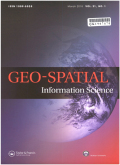- 钛学术文献服务平台 \
- 学术期刊 \
- 基础科学期刊 \
- 天文学、地球科学期刊 \
- 地球空间信息科学学报(英文版)期刊 \
Modeling relationships between the network distance and travel time dynamics for assessing equity of accessibility to urban parks
Modeling relationships between the network distance and travel time dynamics for assessing equity of accessibility to urban parks
基本信息来源于合作网站,原文需代理用户跳转至来源网站获取
摘要:
Static models of accessibility are usually based on the fixed distance or Average Travel Time (ATT) models. Because of ignoring the traffic as a dynamic process affecting the accessibility through the change of Travel Time (TT), these models lead to unperceived temporal inequities. In contrast to the consideration of the temporal Variation of TT (VTT) in the previous studies, the variation of traffic- related TT and its relations with network distance has not been considered. In this study, relations between VTT and network distance to access urban parks in Tehran megacity has been modeled. Traffic maps at five times of day are used to produce TT maps of Traffic Analysis Zones (TAZs) to their 3-closest parks. Comparison of the Gini coefficients of accessibility show significant inequities of accessibility at different times of day. Relations between the distance, ATT, and TTmax are modeled by statistical analysis. Results show both TT and TTmax have significant positive relations with distance and traffic and reach their maximum at 6 p.m. Observation of significant relations between distance, ATT, TTmax, and VTT provides interesting knowledge for the conversion of temporal measures of equity (TT) to a physical measure of equity (distance). A simple application of these findings for effective management of the spatiotemporal inequities is the definition of critical distances from public services. As an example, to decrease the TTmax of TAZs to less than 12 min, their maximum distance to the closest parks should be less than 4 km. The developed approach can be adopted for the accessibility evaluation of the other public services, particularly the health and education centers.

推荐文章
谱归一化Wasserstein distance迁移网络
Wasserstein distance
迁移学习
Lipschitz约束
谱归一化
Assessment of bacterial biomass in the highly contaminated urban Nanming River, Guiyang, SW China
δ13C
δ15N
Bacterial biomass
N budget
Nanming River
Theoretical calculation of equilibrium Mg isotope fractionation between silicate melt and its vapor
Equilibrium Mg isotope fractionation
Force constant
Structural optimization
RPFR
内容分析
关键词云
关键词热度
相关文献总数
(/次)
(/年)
文献信息
| 篇名 | Modeling relationships between the network distance and travel time dynamics for assessing equity of accessibility to urban parks | ||
| 来源期刊 | 地球空间信息科学学报(英文版) | 学科 | |
| 关键词 | |||
| 年,卷(期) | 2021,(3) | 所属期刊栏目 | |
| 研究方向 | 页码范围 | 509-526 | |
| 页数 | 18页 | 分类号 | |
| 字数 | 语种 | 英文 | |
| DOI | |||
五维指标
引文网络
引文网络
二级参考文献 (0)
共引文献 (0)
参考文献 (0)
节点文献
引证文献 (0)
同被引文献 (0)
二级引证文献 (0)
2021(0)
- 参考文献(0)
- 二级参考文献(0)
- 引证文献(0)
- 二级引证文献(0)
引文网络交叉学科
相关学者/机构
期刊影响力
地球空间信息科学学报(英文版)
主办单位:
武汉大学(原武汉测绘科技大学)
出版周期:
季刊
ISSN:
1009-5020
CN:
42-1610/P
开本:
16开
出版地:
武汉市珞瑜路129号武汉大学测绘校区
邮发代号:
创刊时间:
1998
语种:
eng
出版文献量(篇)
958
总下载数(次)
0
总被引数(次)
2719
期刊文献
相关文献
推荐文献
- 期刊分类
- 期刊(年)
- 期刊(期)
- 期刊推荐
力学
化学
地球物理学
地质学
基础科学综合
大学学报
天文学
天文学、地球科学
数学
气象学
海洋学
物理学
生物学
生物科学
自然地理学和测绘学
自然科学总论
自然科学理论与方法
资源科学
非线性科学与系统科学
地球空间信息科学学报(英文版)2022
地球空间信息科学学报(英文版)2021
地球空间信息科学学报(英文版)2020
地球空间信息科学学报(英文版)2019
地球空间信息科学学报(英文版)2018
地球空间信息科学学报(英文版)2017
地球空间信息科学学报(英文版)2016
地球空间信息科学学报(英文版)2015
地球空间信息科学学报(英文版)2014
地球空间信息科学学报(英文版)2013
地球空间信息科学学报(英文版)2012
地球空间信息科学学报(英文版)2011
地球空间信息科学学报(英文版)2010
地球空间信息科学学报(英文版)2009
地球空间信息科学学报(英文版)2008
地球空间信息科学学报(英文版)2007
地球空间信息科学学报(英文版)2006
地球空间信息科学学报(英文版)2005
地球空间信息科学学报(英文版)2004
地球空间信息科学学报(英文版)2003
地球空间信息科学学报(英文版)2002
地球空间信息科学学报(英文版)2001
地球空间信息科学学报(英文版)2000

 免费查重
免费查重










